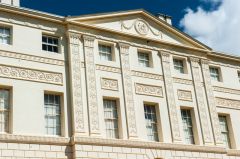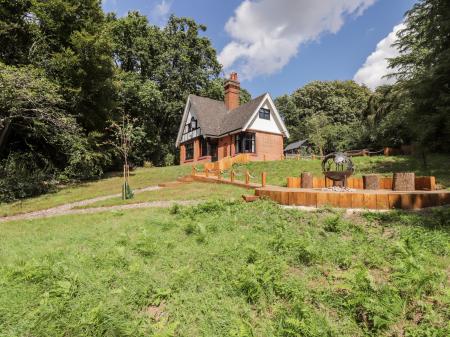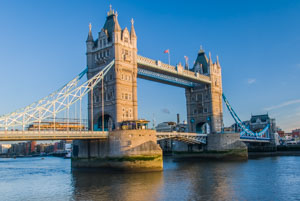
History
The first house at Kenwood dates to the late 17th century and was built by William Brydges around 1694. In 1754 the house was purchased by William Murray, later to become the 1st Earl of Mansfield. Murray would go on to serve as Attorney-General and Lord Chief Justice. Ten years into his occupation of Kenwood, Murray decided to remodel the outmoded house and create a weekend villa for occasional entertaining.
Murray's choice of architect was not a difficult one; Robert Adam, a fellow Scot, was then the most fashionable architect in England, sought after by high society. Adam was engaged in building Osterley Park and Syon House, now swallowed up in the western suburbs of London but then peaceful oases of country calm. Murray gave Adam almost free reign at Kenwood, and the result is one of 18th century England's great neo-classical houses.

Adam was restricted by the existing layout of the house and the presence of an orangery at angles to the west end of the house. He remodelled the orangery and balanced out the facade by creating a matching reception room on the east end of the house. He raised the house by one storey and added an imposing entrance portico.
Though the design is a triumph, one aspect of Kenwood was less successful; Adam decided to use an experimental form of cream-coloured stucco to finish the decoration. The stucco did not last and the garden front had to be completely refaced in 1793.
The result left the facade almost featureless. Fortunately, Adam's original architectural drawings survived, and his designs have been completely remade using fibreglass, so that today the facade looks as Adam intended.
The interior is relatively restrained - by Adam standards - until you come to his new room at the east end. Nominally a library, this chamber has bookshelves set into alcoves, with the central area kept clear for entertaining, and the whole is surmounted by a lovely curved ceiling.

Murray's original intention of using Kenwood as an occasional escape from London life was changed dramatically in 1780 when the anti-Catholic Gordon Riots broke out and his townhouse was burned down by rioters. He retreated to Kenwood and made it his primary residence.
The 2nd Earl Mansfield extended the house, adding two wings to the entrance front and rebuilding the stables and service wing. His architect was George Sanders, and his work could not be more starkly opposite to Adam's.
In 1922 the house was slated to be demolished, but the 1st Earl of Iveagh bought Kenwood to save it from destruction. When he died in 1927 he left Kenwood to the London County Council, and with it, his superb art collection. It is that collection that makes Kenwood such a rewarding place to visit today, set off by Sander's rather plain interiors.

Though most attention at Kenwood should go to the house and its wonderful art collection, the grounds are something special, too. Designed partly by Adam, they include a sham bridge that hides a dam.
Adam prepared the grounds carefully to allow vistas to distant Greenwich and St Paul's Cathedral, but the surrounding trees have grown up so much that these views are obscured, leaving Kenwood wrapped in peaceful isolation in its own green valley.
Kenwood House is operated by English Heritage, and in addition to regular opening hours to enjoy the interiors and art, they use it as a venue for regular events, including concerts and fireworks displays.
Summing up
Kenwood is one of London's treasures, often overlooked by the hordes descending on more easily accessed sites like Apsley House or Kensington Palace. Yet Kenwood is every bit as interesting, and the superb parkland setting makes it unlike any other historic house in the London area.
Now that the multi-million-pound restoration of the interiors is complete, the interior can be appreciated for what it is; one of the finest 18th-century interiors in England. I dare you to walk into the Library and not gasp in astonishment. The Adam touch here is exquisite, with soft pastel tones and elegant plasterwork creating a wedding cake interior of the highest quality.

I was looking forward to seeing the Adam interiors, but I must give a big thumbs up for the artwork on show at Kenwood. The interior is full to bursting with a fabulous display of art, most from the 17th-19th century, with such luminaries as Gainsborough, Vermeer, and Angelica Kauffman represented. Undoubtedly the most popular painting at Kenwood is a self-portrait by Rembrandt. A volunteer guide told us that some visitors rush through the rooms just to see the Rembrandt. And it is well worth seeing; a true masterpiece by a master artist.
A short walk from the house is the Dairy, which is elegant enough to be a stately home in miniature. I had to wonder if the dairymaid appreciated her working conditions! Unfortunately, the Dairy has restricted opening hours, so do check ahead if you'd like to see the interior.
Visiting
The nearest tube stations are Golders Green or Archway, then bus 210. If you fancy a walk across Hampstead Heath (it is worth it!) I've used Hampstead tube station then walked up Parliament Hill to the Heath. If you are coming by car there is a very small English Heritage paid parking area at West Lodge off Hampstead Lane, and if you are lucky (like we were) you can find a free parking space on Hampstead Lane itself and take a short walk from the West Gate to the house.






 We've 'tagged' this attraction information to help you find related historic attractions and learn more about major time periods mentioned.
We've 'tagged' this attraction information to help you find related historic attractions and learn more about major time periods mentioned.



